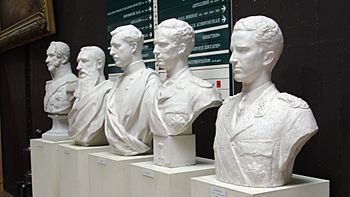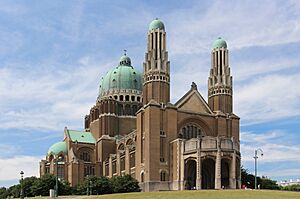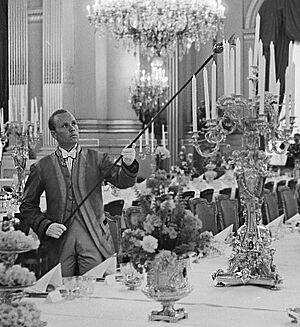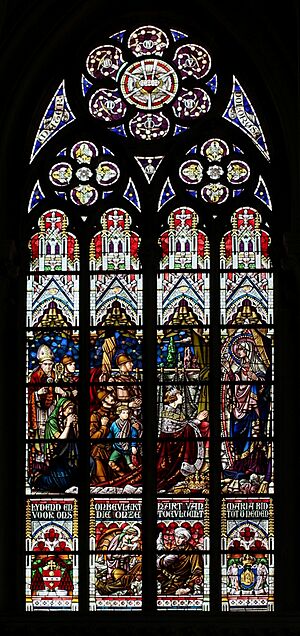Monarchy of Belgium facts for kids
Quick facts for kids King of the Belgians |
|
|---|---|
| Koning der Belgen (Dutch) Roi (French)/Reine des Belges König(in) der Belgier (German) |
|
|
Federal
|
|
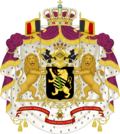
Royal coat of arms of Belgium
|
|
| Incumbent | |
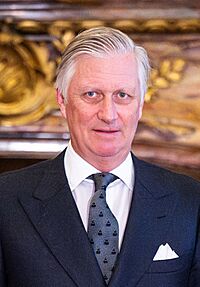 |
|
| Philippe since 21 July 2013 |
|
| Details | |
| Style | His Majesty |
| Heir apparent | Princess Elisabeth, Duchess of Brabant |
| First monarch | Leopold I |
| Formation | 21 July 1831 |
| Residence |
|
| House of Belgium |
|||
|---|---|---|---|
| Parent House: | Saxe-Coburg and Gotha | ||
| Founder: | Leopold I of Belgium | ||
| Current Head: | Philippe | ||
| Founding Year: | 1831 | ||
The monarchy of Belgium is a special system where the King or Queen is the head of state. It's a constitutional monarchy, meaning the King's powers are set by the country's Constitution. It's also hereditary, so the role passes down through the family.
The Belgian monarch is called the King or Queen of the Belgians. This title shows that the monarch is connected to the people, not just the land. The King or Queen acts as the country's leader and the head of the Belgian Armed Forces.
Since Belgium became independent in 1830, there have been seven Kings. The current King is Philippe. He became King on July 21, 2013, after his father, Albert II, decided to step down.
Contents
How the Monarchy Started
When Belgium became independent from the United Kingdom of the Netherlands in 1830, its leaders had to choose a way to govern. The National Congress decided on a constitutional monarchy. This means a king or queen would lead, but their power would be limited by a constitution.
In February 1831, they offered the crown to Louis, Duke of Nemours, the son of the French King. However, the French King did not accept this offer for his son.
After this, Erasme-Louis, Baron Surlet de Chokier was chosen to be the temporary leader, called the Regent. Then, Leopold of Saxe-Coburg-Saalfeld was chosen as the first King of the Belgians. He promised to follow the Belgian Constitution on July 21, 1831. This day is now a national holiday in Belgium.
A King for the People
Belgium's monarchy is both hereditary and constitutional. This means the King's job is passed down in the family, but the Constitution controls what the King can and cannot do. Only a descendant of the first King, Leopold I, can become King.
The King must follow the Constitution above all else. This helps the King act as a fair leader who protects Belgium's unity and independence. Belgian monarchs take an oath in a public ceremony, not a religious one.
Early Kings: Leopold I, Leopold II, and Albert I
King Leopold I was very involved in foreign affairs. He also became a major shareholder in a large Belgian company.

Leopold's son, King Leopold II, is known for creating the Congo Free State in Africa as his personal territory. There were many problems and difficult times in the Congo Free State. Later, the Belgian Government took control of the area. The story of the Congo Free State is told at the Museum of the Congo in Tervuren, Belgium. Leopold II sometimes disagreed with the government, which was unusual for a constitutional monarch.
Leopold II did not have any sons who lived to inherit the throne. So, the next King was his nephew, Albert I of Belgium. King Albert I ruled during World War I, when most of Belgium was taken over by German forces. He is also known for his role in the Belgian Congo and later, Ruanda-Urundi. In 1934, King Albert I died while rock-climbing at Marche-les-Dames.
Leopold III and Baudouin
Leopold III of Belgium believed the King's oath meant he was "above the Constitution." He saw the King as a father figure for the country.
Later, during the reign of King Baudouin, some people pointed out parts of the Constitution that seemed less democratic. For example, the King chose ministers and had a say in new laws. However, the King's actions always needed a minister's approval.
How the Monarchy Changed
The Belgian monarchy was designed to be constitutional from the start, similar to the United Kingdom's system. However, in Belgium, the monarchy, the parliament, and the independent state all began at the same time in 1830. This meant the King's exact powers were not always clearly defined at first.
The Belgian monarchy is not just a symbol. The King helps guide the country's affairs, especially when his ideas match those of the ministers. The King is an important part of the government, even if he doesn't rule alone.
Kings of the Belgians
The first Belgian monarchs belonged to the House of Saxe-Coburg and Gotha. In 1920, King Albert I changed the family name to the House of Belgium. He also removed the symbols of Saxony from the Belgian royal coat of arms. This happened because of strong anti-German feelings after World War I.
In 2019, King Philippe brought back the Saxonian symbols to his personal coat of arms and those of his family. This happened after he visited the ancestral Friedenstein Castle. The King wanted his motto to include all three official languages (French, Dutch, German). This shows his wish to be the King of all Belgians. The national Coat of arms of Belgium itself did not change.
Since 2017, the title "Saxe-Cobourg-Gotha" is used again for most descendants of Leopold I, along with "of Belgium." However, King Philippe, his wife, his sister, and his brother still use only "of Belgium."
Princess Delphine of Belgium (born 1968) is also part of the royal family. She is the legally recognized half-sister of King Philippe. Her children are also recognized as members of the royal family.

The King's Title
The Belgian monarch's title is "King of the Belgians" instead of "King of Belgium." This is special in Europe. It means the King is connected to the people, not just the land. It suggests the King is chosen by the people as a symbolic leader, not an all-powerful ruler.
In Belgium, the heir to the throne does not become King immediately when the old King dies or steps down. According to Article 91 of the Belgian constitution, the new King must take an oath in front of both Houses of Parliament. This must happen within ten days. The King promises to follow the Constitution and protect Belgium's independence. This oath is said in French, Dutch, and German.
Members of the Belgian royal family often have two names, one Dutch and one French. For example, the current King is 'Philippe' in French and 'Filip' in Dutch.
While King Philippe is "King of the Belgians," his daughter, Princess Elisabeth, is called "Princess of Belgium." She is also the Duchess of Brabant, which is the traditional title for the person who will inherit the throne.
During World War I, the royal family changed its name from Saxe-Coburg-Gotha to "of Belgium" (van België, de Belgique, or von Belgien). This was due to strong anti-German feelings. Other royal families, like the British, also changed their names for similar reasons.
However, in 2019, King Philippe brought back the Saxonian shield to the royal family's coat of arms. This happened after he and Queen Mathilde visited their ancestral castle.
The King's Role in Government
The Belgian monarchy helps keep a feeling of national unity. The King represents Belgium at public events and international meetings.
The King also has important duties when a new government is being formed. After an election, the King usually appoints someone to find out which political parties can work together. This person is called an "Informateur." Then, the King might appoint a "Formateur" to actually create the new government. This person often becomes the Prime Minister.
Article 37 of the Constitution of Belgium says the King has "federal executive power." This means the King appoints and removes ministers, carries out laws, suggests new laws to Parliament, and manages international relations. The King signs and announces all laws passed by Parliament.
However, the King must act through the ministers. The King's actions are not valid unless a minister also signs them. This means the government, not just the King, is responsible for these actions. The government is accountable to the Chamber of Representatives.
The King meets with the Prime Minister at least once a week. He also meets with other government members to discuss political matters. In these meetings, the King has the right to be informed, to advise, and to warn. The King also meets with leaders of political parties and members of parliament. These meetings are organized by the King's personal staff.
The King is the Commander-in-Chief of the Belgian Armed Forces. He approves appointments to high military positions. The King's military duties are supported by his Military Household. Belgians can also write to the King if they have problems with government offices.
The King is also part of the law-making process, along with the two parts of the Federal Parliament: the Chamber of Representatives and the Senate. All laws passed by Parliament must be signed and announced by the King.
Before 2014, children of the King could automatically become senators at age 18. This rule was changed.
King's Protection from Law
In Belgium, the King or Queen is protected from legal action while they are ruling. This is called "Inviolability" and is in Article 88 of the Belgian Constitution.
This rule means the King cannot be sued or charged with a crime for actions taken as monarch. This helps the King do their job without fear of political problems.
However, this protection does not cover actions outside of their official duties. If the King does something illegal in their personal life, they can still be held responsible.
Inviolability is important for Belgium's constitutional monarchy. It helps the King be a unifying figure for all Belgians.
Royal Traditions
The Belgian Court keeps some old traditions. One famous tradition is that the King becomes the godfather of a seventh son born in a family. The Queen becomes the godmother of a seventh daughter. The child is then named after the King or Queen and receives a gift.
Another old tradition is the "Joyous Entry." This is a special welcome the new King receives in the country. This tradition goes back centuries to the Dukes of Brabant.
Support for the Monarchy
Historically, more people in Flanders supported the monarchy, while fewer people in Wallonia did. This was partly because the Catholic Party, which supported the monarchy, was strong in Flanders. In Wallonia, the Socialist Party, which was less supportive, had more followers. For example, in a 1950 vote about King Leopold III returning, Flanders voted strongly yes, but Wallonia voted mostly no.
However, in recent years, this has changed. Support for the King has grown in Flanders. Many now see the King as protecting the country from separatism and keeping Belgium united.
The Royal Household
The King's Household is like the King's team of helpers. It was reorganized in 2006 and has seven main departments. Each department head reports to the King.
These departments help the King with many tasks:
- Economic, Social, and Cultural Affairs
- The King's Cabinet (for political and administrative matters)
- The King's Military Household (for defense matters)
- The King's Civil List (for managing money and resources)
- Foreign Relations
- Court Protocol (for organizing events)
- Petitions (for handling requests from the public)
The Chief of Cabinet helps the King stay updated on events in Belgium and around the world. They also help prepare speeches and arrange meetings.
The Head of the Military Household helps the King with defense duties. They inform the King about security and the Belgian Armed Forces. They also organize the King's visits with the military.
The Intendant of the King's Civil List manages the money and staff for the King's Household. They also oversee the royal palaces and residences.
The Chief of Protocol organizes the King and Queen's public events. This includes receptions, banquets, and official visits.
Other departments advise the King on different topics, like the economy, foreign policy, and public requests.
The Belgian Federal Police provides security for the King, the royal family, and the royal estates.
The Royal Family
Members of the Belgian royal family, other than the King, are called Prince or Princess of Belgium. Before World War I, they also used the titles Prince or Princess of Saxe-Coburg and Gotha.
The title Prince or Princess of Belgium is special. It used to be for all male descendants of Leopold I. In 1991, it was changed to include both male and female descendants of Albert II. In 2015, the rules changed again. Now, only the children and grandchildren of the reigning monarch, and the children and grandchildren of the crown prince or princess, get this title. Spouses of princes or princesses no longer automatically get the title.
King Philippe (born April 15, 1960) is the current King. He married Jonkvrouwe Mathilde d'Udekem d'Acoz on December 4, 1999. She became Princess Mathilde and later Queen Mathilde. They have four children:
- Princess Elisabeth, Duchess of Brabant: She is the next in line to the throne. A 1991 law changed the rules so the eldest child, regardless of gender, inherits the throne.
- Prince Gabriel of Belgium
- Prince Emmanuel of Belgium
- Princess Eléonore of Belgium
Other Members of the Royal Family
- King Albert II (born June 6, 1934): He was King from 1993 until July 21, 2013, when he stepped down due to health reasons. He married Donna Paola Ruffo di Calabria on July 2, 1959. She became Queen Paola. They have three children:
- Princess Astrid, Archduchess of Austria-Este (born June 5, 1962): She married Prince Lorenz of Belgium, Archduke of Austria-Este in 1984. She is ahead of her brother Laurent in the line of succession. They have five children:
- Prince Amedeo of Belgium, Archduke of Austria-Este: He married Elisabetta Maria Rosboch von Wolkenstein in 2014. They have two daughters and one son.
- Princess Maria Laura of Belgium, Archduchess of Austria-Este: She married William Isvy in 2022. They have one son.
- Prince Joachim of Belgium, Archduke of Austria-Este
- Princess Luisa Maria of Belgium, Archduchess of Austria-Este
- Princess Laetitia Maria of Belgium, Archduchess of Austria-Este
- Prince Laurent of Belgium (born October 19, 1963): He married Claire Coombs in 2003. They have one daughter and two sons:
- Princess Delphine of Belgium (born February 22, 1968): She is the daughter of King Albert II. After a court case in 2020, she and her children were recognized as prince/princess of Belgium. She has one daughter and one son:
- Princess Astrid, Archduchess of Austria-Este (born June 5, 1962): She married Prince Lorenz of Belgium, Archduke of Austria-Este in 1984. She is ahead of her brother Laurent in the line of succession. They have five children:
Other Descendants of Leopold III
- Princess Léa of Belgium (born December 2, 1951): She is the widow of Prince Alexandre of Belgium, who was King Philippe's half-uncle.
- Princess Marie-Christine, Mrs Gourgues (born February 6, 1951): She is King Philippe's half-aunt.
- Princess Marie-Esméralda, Lady Moncada (born September 30, 1956): She is King Philippe's half-aunt. She is a journalist. She married Sir Salvador Moncada in 1998. They have a daughter and a son.
Family Tree of Members
| Family tree | ||||||||||||||||||||||||||||||||||||||||||||||||||||||||||||||||||||||||||||||||||||||||||||||||||||||||||||||||||||||||||||||||||||||||||||||||||||||||||||||||||||||||||||||||||||||||||||||||||||||||||||||||||||||||||||||||||||||||||||||||||||||||||||||||||||||||||||||||||||||||||||||||||||||||||||||||||||||||||||||||||||||||||||||||||||||||||||||||||||||||||||||||||||||||||||||||||||||||||||||||||||||||||||||||||||||||||||||||||||||||||||||||||||||||||||||||||||||||||||||||||||||||||||||||||||||||||||||||||||||||||||||||||||||||||||||||||||||||||||||||||||||||||||||||||||||||||||||||||||||||||||||||||||||||||||||||||||||||||||||||||||||||||||||||||||||||||||||||||||||||||||||||||||||||||||||
|---|---|---|---|---|---|---|---|---|---|---|---|---|---|---|---|---|---|---|---|---|---|---|---|---|---|---|---|---|---|---|---|---|---|---|---|---|---|---|---|---|---|---|---|---|---|---|---|---|---|---|---|---|---|---|---|---|---|---|---|---|---|---|---|---|---|---|---|---|---|---|---|---|---|---|---|---|---|---|---|---|---|---|---|---|---|---|---|---|---|---|---|---|---|---|---|---|---|---|---|---|---|---|---|---|---|---|---|---|---|---|---|---|---|---|---|---|---|---|---|---|---|---|---|---|---|---|---|---|---|---|---|---|---|---|---|---|---|---|---|---|---|---|---|---|---|---|---|---|---|---|---|---|---|---|---|---|---|---|---|---|---|---|---|---|---|---|---|---|---|---|---|---|---|---|---|---|---|---|---|---|---|---|---|---|---|---|---|---|---|---|---|---|---|---|---|---|---|---|---|---|---|---|---|---|---|---|---|---|---|---|---|---|---|---|---|---|---|---|---|---|---|---|---|---|---|---|---|---|---|---|---|---|---|---|---|---|---|---|---|---|---|---|---|---|---|---|---|---|---|---|---|---|---|---|---|---|---|---|---|---|---|---|---|---|---|---|---|---|---|---|---|---|---|---|---|---|---|---|---|---|---|---|---|---|---|---|---|---|---|---|---|---|---|---|---|---|---|---|---|---|---|---|---|---|---|---|---|---|---|---|---|---|---|---|---|---|---|---|---|---|---|---|---|---|---|---|---|---|---|---|---|---|---|---|---|---|---|---|---|---|---|---|---|---|---|---|---|---|---|---|---|---|---|---|---|---|---|---|---|---|---|---|---|---|---|---|---|---|---|---|---|---|---|---|---|---|---|---|---|---|---|---|---|---|---|---|---|---|---|---|---|---|---|---|---|---|---|---|---|---|---|---|---|---|---|---|---|---|---|---|---|---|---|---|---|---|---|---|---|---|---|---|---|---|---|---|---|---|---|---|---|---|---|---|---|---|---|---|---|---|---|---|---|---|---|---|---|---|---|---|---|---|---|---|---|---|---|---|---|---|---|---|---|---|---|---|---|---|---|---|---|---|---|---|---|---|---|---|---|---|---|---|---|---|---|---|---|---|---|---|---|---|---|---|---|---|---|---|---|---|---|---|---|---|---|---|---|---|---|---|---|---|---|---|---|---|---|---|---|---|---|---|---|---|---|---|---|---|---|---|---|---|---|---|---|---|---|---|---|---|---|---|---|---|---|---|---|---|---|---|---|---|---|---|---|---|---|---|---|---|---|---|---|---|---|---|---|---|---|---|---|---|---|---|---|---|---|---|---|---|---|---|---|---|---|---|---|---|---|---|---|---|---|---|---|---|---|---|---|---|---|---|---|---|---|---|---|---|---|---|---|---|---|---|---|---|---|---|---|---|---|---|---|---|---|---|---|---|---|---|---|---|---|---|---|---|---|---|---|---|---|---|---|---|---|---|---|---|---|---|---|---|---|---|---|---|---|---|---|---|---|---|---|---|---|---|---|---|---|---|---|---|---|---|---|---|---|---|---|---|---|---|---|---|---|---|---|---|---|---|---|---|---|---|---|---|---|---|---|---|---|---|
|
||||||||||||||||||||||||||||||||||||||||||||||||||||||||||||||||||||||||||||||||||||||||||||||||||||||||||||||||||||||||||||||||||||||||||||||||||||||||||||||||||||||||||||||||||||||||||||||||||||||||||||||||||||||||||||||||||||||||||||||||||||||||||||||||||||||||||||||||||||||||||||||||||||||||||||||||||||||||||||||||||||||||||||||||||||||||||||||||||||||||||||||||||||||||||||||||||||||||||||||||||||||||||||||||||||||||||||||||||||||||||||||||||||||||||||||||||||||||||||||||||||||||||||||||||||||||||||||||||||||||||||||||||||||||||||||||||||||||||||||||||||||||||||||||||||||||||||||||||||||||||||||||||||||||||||||||||||||||||||||||||||||||||||||||||||||||||||||||||||||||||||||||||||||||||||||
Deceased Members of the Royal Family
Many members of the Belgian royal family have passed away since the monarchy began. Here are some of them:
- Louis Philippe, Crown Prince of Belgium (died 1834)
- Queen Louise-Marie (died 1850)
- King Leopold I (died 1865)
- Emperor Maximilian I of Mexico (died 1867)
- Prince Leopold, Duke of Brabant (died 1869)
- Princess Joséphine-Marie (died 1871)
- Crown Prince Rudolf of Austria (died 1889)
- Prince Baudouin (died 1891)
- Queen Marie Henriette (died 1902)
- Prince Philippe, Count of Flanders (died 1905)
- King Leopold II (died 1909)
- Princess Marie, Countess of Flandres (died 1912)
- Prince Karl Anton of Hohenzollern (died 1919)
- Prince Philipp of Saxe-Coburg and Gotha, Duke in Saxony (died 1921)
- Princess Louise of Saxe-Coburg and Gotha, Duchess in Saxony (died 1924)
- Prince Victor, Prince Napoléon (died 1926)
- Empress Carlota of Mexico (died 1927)
- Prince Emmanuel, Duke of Vendôme and Alençon (died 1931)
- King Albert I (died 1934)
- Queen Astrid (died 1935)
- Crown Princess Stéphanie of Austria, Princess Lónyai de Nagy-Lónya (died 1945)
- Prince Elemér Lónyai de Nagy-Lónya (died 1946)
- Princess Henriette, Duchess of Vendôme and Alençon (died 1948)
- Clémentine, Princess Napoléon (died 1955)
- Princess Joséphine-Caroline of Hohenzollern (died 1958)
- Queen Elisabeth (died 1965)
- King Umberto II of Italy (died 1983)
- Prince Regent Charles, Count of Flanders (died 1983)
- King Leopold III (died 1983)
- King Baudouin I (died 1993)
- Queen Marie-José of Italy (died 2001)
- Lilian, Princess of Réthy (died 2002)
- Grand Duchess Joséphine-Charlotte of Luxembourg (died 2005)
- Prince Alexandre (died 2009)
- Queen Fabiola (died 2014)
- Grand Duke Jean of Luxembourg (died 2019)
Royal Consorts
These are the Queens who were married to the Kings of the Belgians:
- Princess Louise d'Orléans (wife of King Leopold I)
- Archduchess Marie Henriette of Austria (wife of King Leopold II)
- Duchess Elisabeth in Bavaria (wife of King Albert I)
- Princess Astrid of Sweden (first wife of King Leopold III)
- Mary Lilian Baels* (second wife of King Leopold III)
- Doña Fabiola de Mora y Aragón (wife of King Baudouin)
- Donna Paola Ruffo di Calabria (wife of King Albert II)
- Jonkvrouwe Mathilde d'Udekem d'Acoz (wife of King Philippe)
See also
 In Spanish: Monarquía de Bélgica para niños
In Spanish: Monarquía de Bélgica para niños
- List of Belgian monarchs
- List of heirs to the Belgian throne
- Line of succession to the Belgian throne
- Crown Council of Belgium


